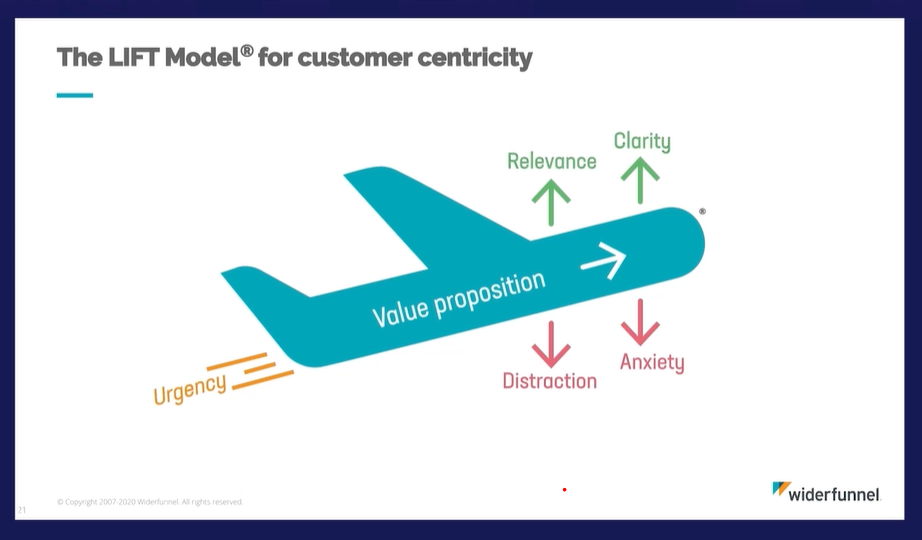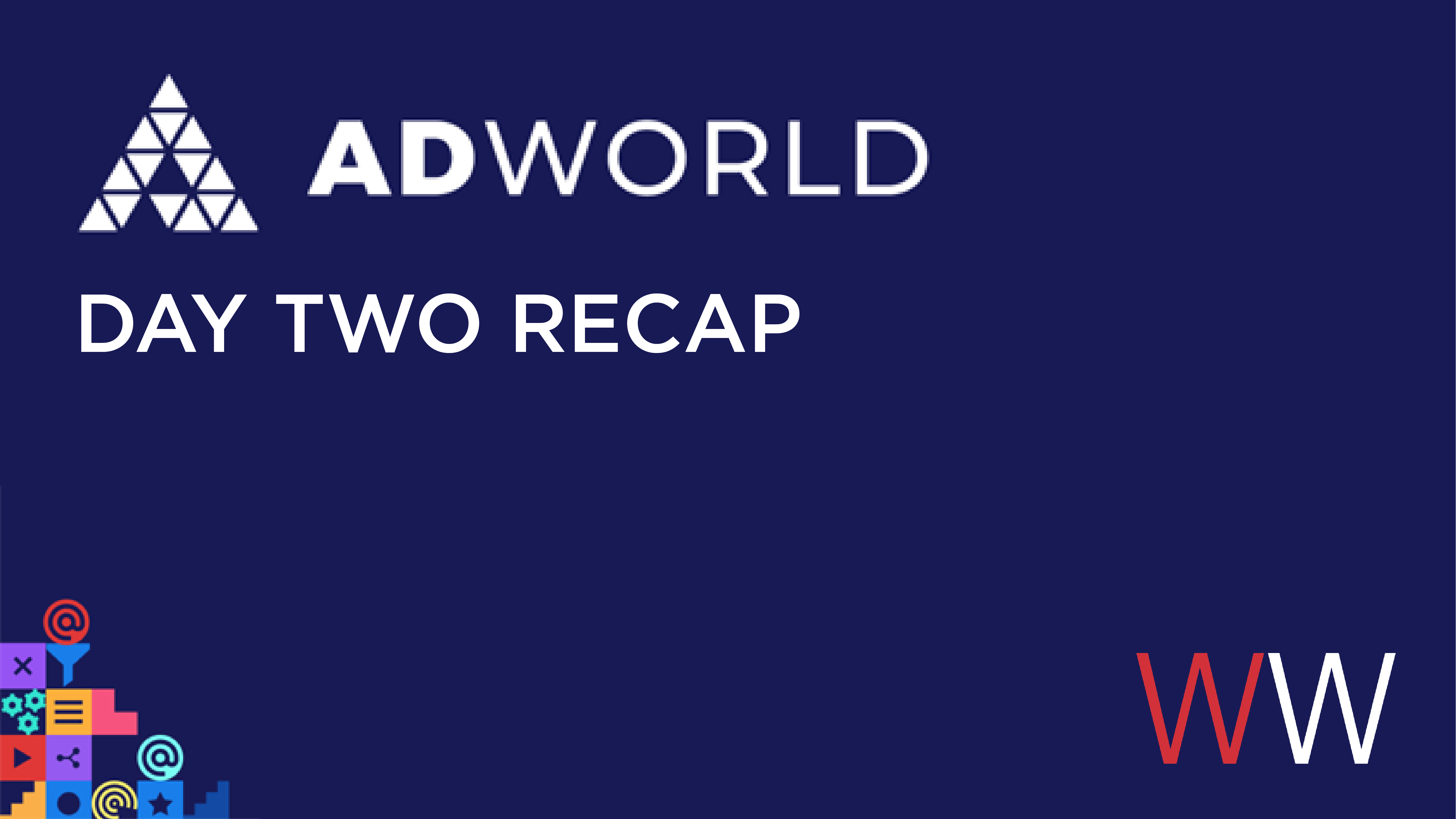By: Holly Gonzalez – Account Executive @ Williams Whittle
Today we recap day two from the Ad World Conference 2020. If you missed our day one recap, check it out on the blog.
1. Case Study: How Dollar Shave Club Drives Exponential Growth through Behavioral Experimentation – Chris Goward, Founder & CEO at WiderFunnel
The case study from Dollar Shave Club is unique because it is a subscription-based direct-to-consumer brand. This session shared a tool called the LIFT Model® for evaluating value propositions. It is a tool that enables brands to present themselves in a way that demonstrates how their benefits outweigh their costs.

Photo Credit: widerfunnel
In this model, relevance explains the way in which your brand experience matches the customer’s needs and expectations. Clarity refers to eye flow on your visual brand elements and effective calls to action. Distraction is something that takes away attention from the call to action and anxiety is anything that brings doubt to the desired call to action. This could be in the form of confusing content or missing important content on marketing materials.
Goward walked through key insights that were gained from his experimental testing with Dollar Shave Club. It was particularly interesting to see how well their brand tonality works when it’s woven into all aspects of their product. Dollar Shave Club’s brand is witty and humorous, but they realized by analyzing the brand relevance that the online question tool that was used to determine what unique products to send to the customer sounded too clinical. So, they made edits to change the copy of the questionnaire to be more conversational which increased signups by over 5%.
2. How to Generate 10,000 Leads in a Day with Google Ads – Justin Brooke, Founder at Adskills
Justin Brooke gave a highly practical presentation that outlined key steps to determine your brand’s most effective Google Ad. Here are just a few of his tips on scaling ads. The main point he made was that you are really trying to find gold when running an ad. In order to find this gold, you must test different ad groups as well as different ads. He noted that in the beginning when you are ruling out unsuccessful ad variations you can have 80-90% unprofitability. Then he went through some essential terms to know when working with ads. The first was keyword ads, which run on websites related to that keyword. They are specific and help you find sites that you could then run your ad on sitewide. When you are testing your ads, split them up by keyword themes which are related words rather than keyword variations which are just that “variations” of a word such as “bitcoin” and “bitcoins.” Also, separate your analysis of text ads and image ads. The Google algorithm molds text ads to any size so when compared directly in the same campaign to image ads, they always outperform. Finally, he shared an insight that poll ads are the highest converting lead generating ads. This is because they provide limited options for actual poll answers which leads to easy conversion and they evoke an emotional response. Additionally, if you share with the audience how others voted you are more likely to get traffic to the site.
3. Unveiled: The 3 Factors that Make for a Killer Influencer Campaign – Chrissy Abram, Manager, PR & Influencer Marketing at Later Media
We attended a session on influencer marketing at the MAC Summit so it was exciting to continue to build knowledge in this area. The three factors that make up a successful influencer campaign are broken out into three sections.
- The first is campaign objective, strategy and tactics.
- The second is required content and statement of work
- Last is multiple audiences and engagement tips.
When talking through the campaign objective section, Abram brought up the use of micro and nano influencers. These influencers have less than 10K followers. Utilizing partnerships with these influencers can be a worthwhile alternative to more well-known influencers because they have less sponsored content on their page which will allow your brand to stand out instead of having to compete with content from other brands. Abram also spoke logistically about how to execute these campaigns; stating that brands need to outline in a statement of work what content is needed to be made for the brand’s social channel and the influencer’s channel. More specifically, your brand will need to outline which platforms the influencer is to share on and if resources are needed to make video content beyond the use of an iPhone. Abram explained that the means of success measurement should be clear. Measurement could be through increased web traffic, impressions, reach, etc.
In the multiple audience section, Abram outlined how to go beyond the use of one influencer to the use of multiple influencers or users to amplify your brand reach. This can be accomplished by the use of branded AR filters and hashtags that share your brand identity and encourage users to make connections to your brand through their own posts.
4. How to Build a Profitable Agency Without Becoming a Frantic and Overworked CEO – Dim Niko, Director at DimNiko.com
This session was a little different than the others because it was not revealing any specific industry tips, but rather overall business advice. Even though the session was geared towards advertising agencies, the insights can be applied to any business. First, Niko explained the “must-haves” for a smoothly running agency: concrete organizational structure, standard operating procedures (SOPs) that deliver a repeatable result and a sustainable means of customer acquisition.
The kicker in all these “must-haves” is that once established, the goal is that these structures can operate without CEO involvement. Niko placed an emphasis on service delivery over results delivery. Your goal is to deliver a service that will lead to the best results, but sometimes the results are impacted by factors in and outside of an agency’s control. By focusing on delivering the best possible service, you make sure that your work is staying within the scope of what you were hired to complete. Sometimes you may encounter situations where work outside your scope presents itself, and for this, Niko suggests focusing on your scope but provide templates to help guide your client to completing the outside scope work.
The final points of the presentation focused on employee management. Niko explained that defining what a particular employee’s role does not entail is just as important as outlining what their role is responsible for. This makes an employee’s understanding of their position extremely clear. When developing a handbook on how to handle each new client, Niko suggests outlining the list of tasks that are completed for each client, which can be adjusted. This is more important than an outline of specifically how to do each task because it establishes an understood workflow process.
5. How to Integrate Podcasting into Your Content Strategy & Skyrocket Customer Engagement – Amanda Powell, Director of Content at DigitalMarketer
Podcasts are a hot topic now, we even attended a session on podcasts at the MAC Summit. During this session with Amanda Powell, we learned that the start of developing a successful podcast is knowing your audience, which holds up when developing many other forms of marketing content as well. An understanding of your audience is key to building podcasting that will best serve your audience by speaking to their interests and problems.
Powell shared a tip on using SEO optimization to determine podcast content- it is the use of a chrome extension called Keywords Everywhere. Through this extension, you can learn the search volume of your podcast topic and see what questions potential audience members are asking on search. Powell also advocated for making sure to use your podcast as a means to create more splintered content for your brand. Don’t let podcasting be all you do. Some ideas for splintering content from a traditional podcast include: filming a video recap, sharing tips you discussed in the podcast on social, sharing recording snippets on social and ads, and discussing your topic on social channels.
This conference included three jam-packed days of thought-provoking sessions. We hope you have enjoyed our day one and day two recap. We will close out the week with our final recap on day three tomorrow on the blog.



